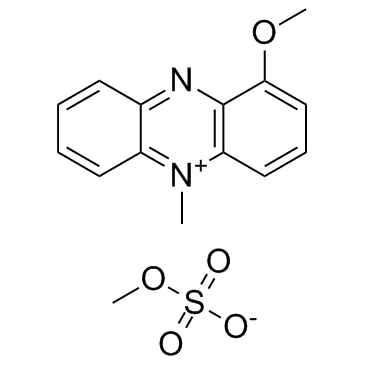Distinct trans-plasma membrane redox pathways reduce cell-impermeable dyes in HeLa cells.
An S Tan, Michael V Berridge
Index: Redox Rep. 9(6) , 302-6, (2004)
Full Text: HTML
Abstract
Trans-plasma membrane electron transport (tPMET) in mammalian cells has been demonstrated using artificial cell-impermeable dyes, but the extent to which reduction of these dyes involves distinct pathways remains unclear. Here we compare the properties of three commonly used dyes, WST-1, FeCN and DCIP. The presence of an intermediate electron carrier (mPMS or CoQ(1)) was obligatory for WST-1 reduction, whereas FeCN and DCIP were reduced directly. FeCN reduction was, however, greatly enhanced by CoQ(1), whereas DCIP was unaffected. Superoxide dismutase (SOD) and aminooxyacetate (AOA), a malate/aspartate shuttle inhibitor, strongly inhibited WST-1 reduction and reduced DCIP reduction by 40-60%, but failed to affect FeCN reduction, indicating involvement of mitochondrial TCA cycle-derived NADH and a possible role for superoxide in WST-1 but not FeCN reduction. Reduction of all three substrates was similarly inhibited by dicoumarol, diphenyleneiodonium and capsaicin. These results demonstrate that WST-1 FeCN and DCIP are reduced by distinct tPMET pathways.
Related Compounds
| Structure | Name/CAS No. | Molecular Formula | Articles |
|---|---|---|---|
 |
1-Methoxy-5-methylphenazinium methyl sulfate
CAS:65162-13-2 |
C15H16N2O5S |
|
Chronic constriction injury-induced nociception is relieved ...
2015-07-01 [Pain 156 , 1320-33, (2015)] |
|
Myo5b knockout mice as a model of microvillus inclusion dise...
2015-01-01 [Sci. Rep. 5 , 12312, (2015)] |
|
Uptake and bio-reactivity of polystyrene nanoparticles is af...
2015-03-07 [Nanoscale 7(9) , 4199-210, (2015)] |
|
Hedgehog Signaling Modulates the Release of Gliotransmitters...
2016-02-01 [Neurochem. Res. 41 , 278-89, (2016)] |
|
Ultrasensitive detection of the reduced form of nicotinamide...
2012-07-21 [Analyst 137(14) , 3328-34, (2012)] |